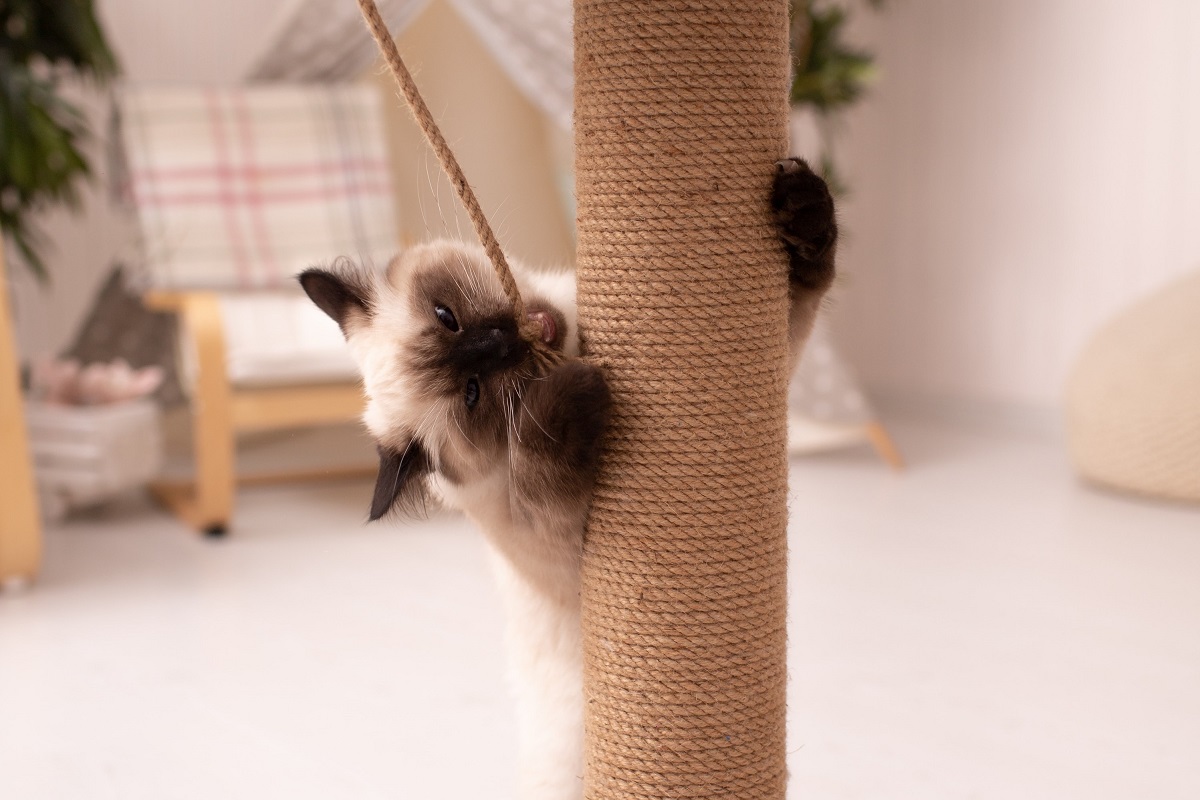You picked the perfect scratching post. It’s tall, covered in sisal, and blends with your living room decor. But your kitten? She would rather shred your couch, your rug, or that one chair you actually liked.
If your kitten is ignoring their scratching post, don’t panic. This is a common kitten conundrum, and it is usually fixable with a little strategy and some feline psychology. Kittens scratch to mark territory, stretch their muscles, and relieve stress, but they do not always know where you want them to do it.
Let’s explore the most common reasons scratching posts get the cold shoulder and how to turn yours into the hottest real estate in the house.
Scratching Is a Natural Behavior, Not a Bad Habit
Before we blame the post, let’s talk about scratching itself. Scratching is not misbehavior. It is an instinct that serves several important functions for cats of all ages:
- Maintaining claw health by removing outer sheaths
- Stretching and flexing the muscles in their back and paws
- Leaving scent marks through glands in their paws
- Visual marking to claim territory
- Stress relief and emotional expression
So if your kitten is scratching your furniture, it is not because they are naughty. It is because they are normal. The trick is helping them understand where scratching is allowed and where it is absolutely not.
Common Reasons Kittens Avoid the Post
If your kitten is turning their nose up at the scratching post, one or more of these issues might be the cause:
1. The post is in the wrong location
Cats scratch to communicate, and they usually want their message seen. If your scratching post is tucked away in a quiet corner, your kitten might not bother using it. Posts placed near high-traffic areas or next to favorite nap spots are more likely to be used.
2. The post is the wrong type or size
Some kittens prefer vertical posts, while others love horizontal scratchers. Some like sisal, others go wild for cardboard. And if the post is too short or flimsy, it might not satisfy their urge to stretch and dig in.
3. They have already claimed a better option
If your kitten has been scratching the couch since day one, they might have mentally assigned it as their territory. At that point, your scratching post is just some strange thing you brought home that smells like a store.
4. It is not broken in yet
New scratching posts smell like absolutely nothing. And in cat world, that means “not mine.” Without a familiar scent or claw marks, your kitten might not understand what to do with it.
5. They need more encouragement
Some kittens need a little incentive to understand what the scratching post is for. If it doesn’t smell like them, and you’re not showing interest in it, they may not either.
How to Get Your Kitten to Use the Scratching Post
Now that we know why your kitten might be ignoring it, let’s talk about how to make the scratching post their new favorite thing.
Put it in the right place
Place scratching posts near where your kitten already scratches. If that means next to the couch or bed for now, so be it. You can move it later once they develop the habit.
Try different styles
Offer a variety of scratching surfaces such as vertical posts, horizontal pads, angled ramps, and different textures like sisal, carpet, and cardboard. Let your kitten decide what feels best.
Use scent and attraction
Rub catnip or silvervine on the scratching surface to pique interest. You can also use pheromone sprays or rub their own scent onto the post with a cloth that has been near their face.
Praise and reward
When your kitten uses the post, tell them they are a genius. Offer a treat or a quick play session. Positive reinforcement helps them understand they are doing something right.
Gently discourage unwanted scratching
If your kitten goes back to the couch, use double-sided tape, citrus scents, or furniture-safe deterrent sprays to make it less appealing. Never yell or punish. Just redirect them calmly to the correct surface.
Make it fun
Turn the scratching post into part of playtime. Dangle toys nearby or use a wand toy to lead them across the surface. Many kittens will scratch as part of the chase.

Ugh, humans, always trying to control everything. So, they got me this so-called “scratching post.” I guess it’s okay. I mean, don’t get me wrong, the texture is divine, and the height is perfect for my stretching needs, but you know what’s even better? The couch! I guess I’ll give it a try, but only when they’re watching. #IStillPreferTheCouch #CouchIsLife #ScratchyKitty
Winston
When Scratching Is About More Than the Post
If your kitten is scratching more than usual or seems unusually intense about it, they might be anxious, bored, or lacking stimulation.
To help prevent stress-based scratching:
- Make sure they have daily play sessions
- Provide cozy hiding spots and vertical spaces to climb
- Keep their environment consistent and calm
- Use calming pheromones if they seem nervous
Scratching can be a form of self-soothing, so creating a predictable and engaging environment can make a big difference in where and how often they do it.
Final Thoughts: The Post Isn’t the Problem
Getting your kitten to use a scratching post is all about making it the most appealing option. Right now, your kitten is just doing what comes naturally, but they need a little guidance to understand that the couch is not the target.
By adjusting the post’s location, style, and scent, and combining that with positive reinforcement, you can help your kitten learn exactly where to put those sharp little claws.
Soon enough, the post will be shredded, the couch will be safe, and you’ll be back to admiring your kitten’s antics instead of covering the furniture with blankets.
Sources:
Understanding Cat Scratching https://www.humanesociety.org/resources/why-cats-scratch
Encouraging Healthy Cat Behavior https://www.icatcare.org/advice/scratching-behaviour-in-cats
How to Stop Unwanted Scratching https://vcahospitals.com/know-your-pet/scratching-behavior-in-cats
Training Your Kitten https://www.petmd.com/cat/behavior/how-train-your-kitten-use-scratching-post
Recent Posts
Your Cat Might Be a Furry Little Healer… or at Least a Fuzzy Alarm System If you’ve ever had your cat suddenly become extra clingy when you’re under the weather, you’re not alone. From...
Cats are experts at hiding things, socks under furniture, their disdain for your playlist, and, unfortunately, symptoms of illness. In the wild, showing weakness could make them a target, so even...


